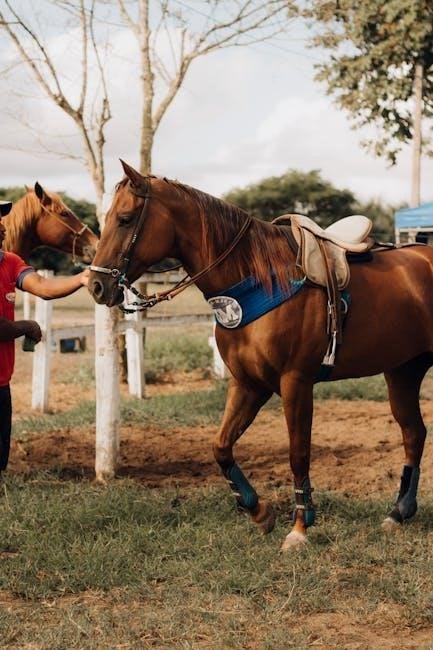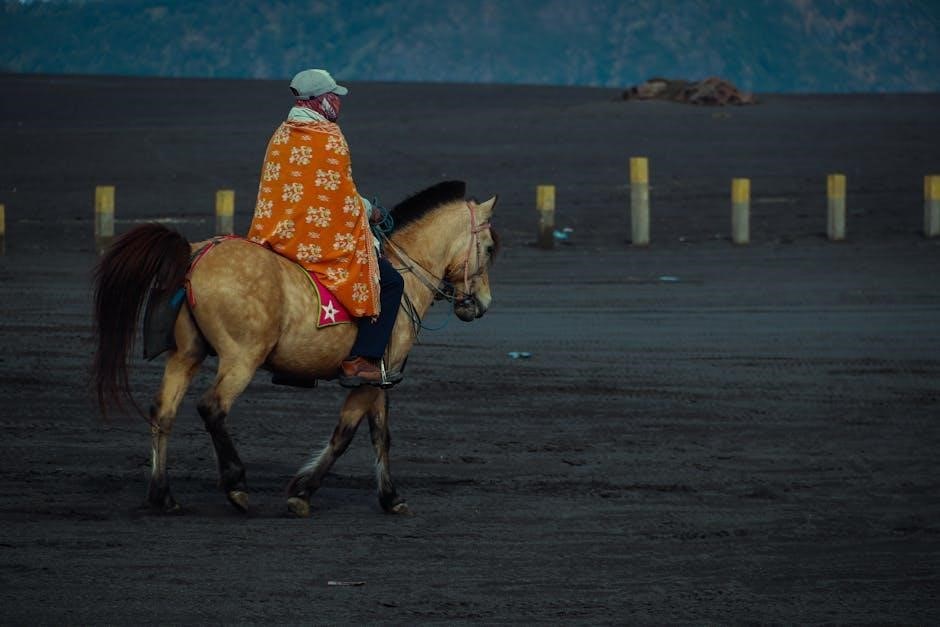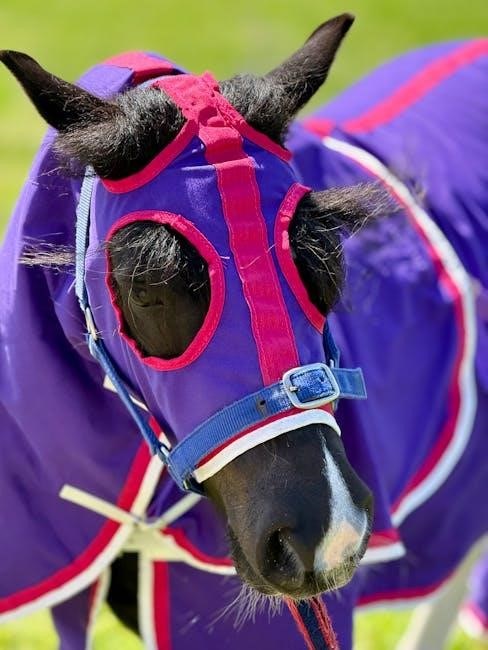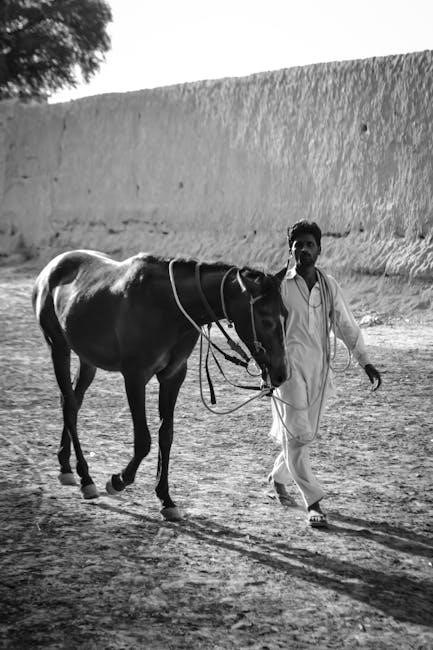Horse owners need a temperature guide to ensure their horses are comfortable and healthy, using
temperature
ranges and weights to determine the best blanket.
Understanding the Importance of Temperature Ranges
Temperature ranges play a crucial role in determining the right horse blanket, as horses have a unique thermal comfort zone. A horse’s temperature should fall within a specific range, typically between 37.5-38.5 degrees Celsius. Understanding these temperature ranges is essential to ensure the horse’s comfort and health. The temperature guide helps horse owners to make informed decisions about blanketing their horses. By considering the temperature range, horse owners can prevent overheating or overcooling, which can lead to discomfort, stress, and even health issues. A good understanding of temperature ranges is vital for horse care, and the temperature guide provides valuable information to help horse owners make the best decisions for their horses. This knowledge is essential for maintaining the horse’s overall well-being and ensuring they remain healthy and happy; Proper temperature management is critical for horse care.
Horse Blanketing Temperature Reference Chart
Reference charts provide temperature guidelines for horse blanketing, helping owners make informed decisions about their horse’s comfort and health using tables and
data.
Clipped Horse Temperature Guide
A clipped horse requires special consideration when it comes to temperature guidelines, as they are more susceptible to cold temperatures due to their reduced coat.
The temperature guide for clipped horses takes into account the outside temperature and the horse’s individual needs, providing a range of blanket weights to ensure their comfort.
A general guideline is to provide a light weight blanket at 50 degrees Fahrenheit and a medium weight blanket at 30 degrees Fahrenheit.
This guide helps horse owners make informed decisions about their clipped horse’s blanketing needs, ensuring they stay warm and healthy.
By following the clipped horse temperature guide, owners can help prevent discomfort and health issues related to cold temperatures.
The guide is an essential tool for any horse owner with a clipped horse, providing peace of mind and ensuring the horse’s overall well-being.

Parts of a Horse Blanket
Horse blankets have various parts, including
neck covers
and
surcingles
, designed for comfort and security, with different materials and styles available.
Types of Horse Blankets
There are several types of horse blankets available, including lightweight, medium weight, and heavyweight blankets, each designed for specific weather conditions and horse needs.
The type of blanket used depends on the temperature and climate, with lighter blankets used in warmer weather and heavier blankets used in colder weather.
A horse sheet is also available, which has no insulation and is used in mild weather or as a layering piece.
The different types of blankets are designed to provide comfort and protection for horses, and are made from a variety of materials, including polyester and nylon.
Each type of blanket has its own unique features and benefits, and horse owners should consider their horse’s individual needs when selecting a blanket.
The various types of blankets allow horse owners to choose the best option for their horse, depending on the temperature and weather conditions.
Horse Blanketing Guide
Horse owners use a guide to determine the best blanket for their horse based on temperature and individual needs using a chart.
When to Blanket Your Horse
To determine when to blanket your horse, consider the temperature and individual needs of your horse. A horse’s age, health, and coat thickness are important factors to consider. Older horses or those with health issues may need to be blanketed sooner than younger, healthier horses. The temperature outside also plays a role in determining when to blanket your horse. If the temperature is expected to drop below a certain point, it may be necessary to blanket your horse to keep them warm. Using a guide or chart can help you make this decision and ensure your horse is comfortable and healthy. By considering these factors, you can make an informed decision about when to blanket your horse and keep them safe and comfortable. Regular monitoring of your horse’s condition is also necessary.

Weight of Horse Blankets
Horse blankets have varying weights, measured in grams, affecting their insulating properties and usage.
Blanket Weights and Recommended Uses
The weight of a horse blanket is a crucial factor in determining its suitability for different weather conditions and horse needs. Lightweight blankets, typically weighing between 100-200gsm, are ideal for mild weather or as a layering piece. Medium weight blankets, with a fill weight of 200-300gsm, provide moderate insulation and are suitable for cooler temperatures. Heavyweight blankets, weighing between 380-440gsm, offer maximum insulation and are recommended for extremely cold weather. Extra-heavy weight stable blankets, with a fill weight of 500gsm, provide the highest level of insulation and are ideal for senior horses or horses that need extra warmth. By choosing the right blanket weight, horse owners can ensure their horses remain comfortable and healthy. A horse blanket temperature guide can help owners make informed decisions about blanket weights and their recommended uses.

Monitoring Your Horse
Regularly check horse temperature and comfort level using a guide.
Checking Temperature and Comfort Level
To ensure the horse’s comfort and health, it is essential to regularly check their temperature and comfort level. This can be done by feeling underneath the blanket to check for sweating or shivering. The horse’s temperature should fall within a specific range, and the comfort level should be assessed based on their individual needs and the weather conditions. A horse blanket temperature guide can provide valuable information on the ideal temperature range and comfort level for horses. By monitoring the horse’s temperature and comfort level, owners can make adjustments to the blanket weight and type to ensure the horse remains comfortable and healthy. This regular checking is crucial in maintaining the horse’s overall well-being and preventing any potential health issues. Owners should consult a veterinarian for personalized advice on checking temperature and comfort level.

Adjusting Blanket Weight
Adjust the blanket weight based on the horse’s individual needs and weather conditions using a
guide
for optimal results always.
Considering Individual Needs and Weather Conditions
To determine the best blanket for a horse, it is essential to consider individual needs and weather conditions, taking into account factors such as age, health, and climate.
Using a
temperature guide
can help horse owners make informed decisions about blanketing their horses.
The guide provides a framework for selecting the right blanket based on temperature ranges and weights, ensuring the horse remains comfortable and healthy.
Additionally, horse owners should monitor their horse’s behavior and adjust the blanket accordingly, as individual needs may vary.
By considering these factors and using a temperature guide, horse owners can provide their horses with the best possible care, regardless of the weather conditions.
This approach helps to prevent overheating or overcooling, promoting the overall well-being of the horse.
Overall, a temperature guide is a valuable resource for horse owners.
A horse blanket temperature guide is essential for horse owners to ensure their horses are comfortable and healthy always using correct temperatures.
Importance of a Horse Blanket Temperature Guide
The importance of a horse blanket temperature guide cannot be overstated, as it provides horse owners with a valuable resource to ensure their horses are comfortable and healthy. By understanding the optimal temperature ranges for their horses, owners can make informed decisions about blanketing. This guide is particularly useful for horse owners who are new to horse care or who are unsure about the best blanketing practices for their horses. A horse blanket temperature guide can help prevent overheating or overcooling, which can lead to discomfort and health problems. With a temperature guide, horse owners can confidently provide their horses with the right level of blanketing, regardless of the weather or season. This helps to promote the overall well-being and happiness of the horse. Regular use of the guide can also help to prevent unnecessary veterinary visits.
